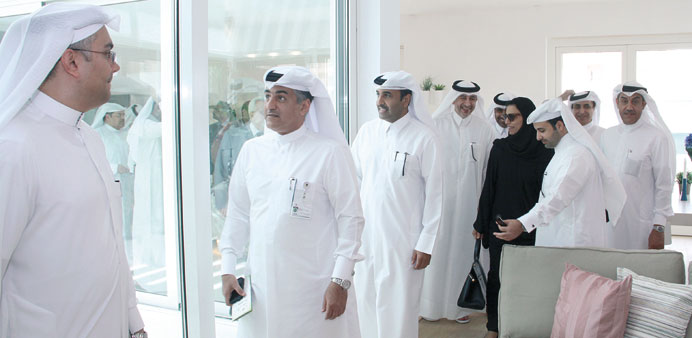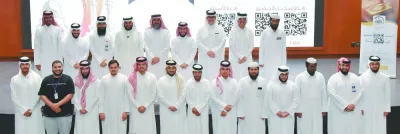Qatar’s first ultra-low energy villa, a landmark project that could revolutionise the way people think about building homes in the entire Middle East region, was launched at the Barwa City in Doha yesterday. Following months of planning, design and construction, Qatar Green Building Council (QGBC), Kahramaa and Barwa Real Estate Group (BRE) celebrated the completion of the first Passivhaus (“passive house” in English) villa, marking a major shift in the country’s burgeoning construction industry. Senor representatives from the Ministry of Environment, QGBC, Kahramaa and more than 50 partners involved in the construction attending the opening.
By Bonnie James/Deputy News Editor
The Baytna project, Qatar’s first Passivhaus experiment, which was officially opened yesterday in Barwa City at Mesaimeer, will witness a number of testing and studies over the next couple of years.
Baytna is Arabic for ‘Our Home.’ Passivhaus, German for Passive House, is described as the fastest growing energy performance standard in the world with more than 30,000 buildings realised to date with the majority of those since the turn of the century.
The project – jointly implemented by Qatar Green Building Council (QGBC), Barwa Real Estate Group (BRE) and Qatar General Electricity & Water Corporation (Kahramaa) - features two side-by-side 225sq m villas, to compare the energy use and environmental footprint.
The conventional villa is built to a one-star Global Sustainability Assessment System (GSAS) standard whereas the Passivhaus villa will consume 50% less energy and water, resulting in a halving of carbon footprint.
Super insulation and thermal mass, allows a Passivhaus to decouple the internal environment from the harsh external conditions. The energy efficiency measures also include high performance glazing, mechanical ventilation with heat/cold recovery, low energy lighting, low air leakage rates, high efficiency air-conditioning, and solar energy tapped through photovoltaic (PV) monocrystalline silicon panels on the roof.
The solar modules, supplied by Qatar Solar Technologies, have an installed power of 34 kilowatt peak and will produce around 58,000 kilowatt hours of electricity per year, helping avoid about 35 metric tons of CO2 emissions per year.
Solar power will provide all of Passivhaus’ electricity requirements, with excess power to be fed into Kahramaa’s power grid during the day. Since no batteries have been installed to store the solar power, the Passivhaus will draw electricity from Kahramaa after daylight hours.
The calibration of both villas’ base energy and water loads is to start early May and completed by the end of October. Untrained families are expected to live in the villas from beginning of November 2013 to end of April 2014.
Thereafter, the families are to be trained and again live in the villas from May 2014 to November 2014. A publication of results and conclusions are slated for end of February 2015.
One of the main study aims to demonstrate that the Passivhaus can achieve carbon neutrality by annually exporting into Kahramaa’s grid more energy than the annual operational demand.
The Bionest experiment involves the recycling of both black and grey water, and the Polypipe Terrain experiment features a new irrigation technique that delivers water to the root base of shrubs and trees eliminating wasted water.
The PV array cleaning experiment involves the testing of a new cleaning method that uses a large movable wiper blade. Half the PV array will be fitted with the new cleaning device and then its efficacy compared to the remaining half which is to be cleaned manually. The energy generated by both sections will be compared as well as the capital cost, water consumption and maintenance issues associated with each cleaning method.
The effect of thermal mass is to be monitored through the heat profile and heat flow through the wall and roof structural elements. The effect of greater or less thermal mass in maintaining stable and comfortable temperature conditions within the living spaces of both villas can then be assessed and optimised.
The villas are to be assessed using the latest editions of GSAS and LEED (Leadership in Energy and Environmental Design), including a capital cost analysis. The PV surplus feed-in experiment involves monitoring the export of solar energy generated and import of grid electrical energy. A net negative balance is anticipated, with more electrical energy being exported to the grid from the Passivhaus than is imported. Demonstration and quantification will be used to establish the subsequent carbon payback periods.
The Passivhaus standard was developed in Germany in the early 1990s by Professors Bo Adamson of Sweden and Wolfgang Feist of Germany and the first dwellings to be completed to the Passivhaus Standard were constructed in Darmstadt in 1991.
Senior representatives from the Ministry of Environment, QGBC, BRE, Kahramaa and more than 50 partners involved in the construction attended the opening event yesterday.
QGBC, BRE and Kahramaa have established a scientific working committee to collaborate on the project’s many experiments, and conduct extensive monitoring of the Passivhaus principles and low-carbon technologies being implemented.
The partners involved in the construction of the villas include: Ministry of Municipality & Urban Planning, GORD, GE Energy, Texas A&M University at Qatar, Siemens, EPS, Qatar Solar Technologies, Qatar Project Management, AECOM, Bilfinger Berger, Electro-Mechanical Enterprises in Qatar, Al Nakheel, ETA Star, Sharpoonji Pallonji, Waseef, Apriori Group, Red Dot Films, QDRJ Model Company, IMAR, Smeet, Domopan, Gulf Contracting, Terrain Polypipes Gulf, Daikin McQuay Middle East, Alumco, ALBINA, Jersey Group, Tadmur, FTC Qatar WLL, CTBA, Techno-Q, 3DS, Khazanah, Gazzaoui & Partners – Qatar W.L.L., Don Construction Products, Ideal Standard International, Specialties Qatar, Almuftah Group, QPPC, Hunter Douglas, Innovations Unlimited ME, Doha Extraco, BG2 Global Qatar, Parketi Pozgaj, CMC, Premier, Hempel, Meel Hill Ent., Averda Qatar, and Bin Omran Trading & Contracting.



